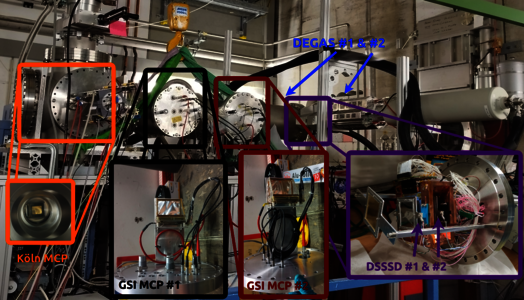AGATA
AGATA (Advanced Gamma Tracking Array) is a European research project with the aim of developing and building a 4pi gamma-ray spectrometer of the next generation. It will be used in experiments utilising both intense stable and radioactive ion beams, to study the structure of atomic nuclei as a function of angular momentum, isospin, and temperature at the limits of their stability. AGATA is based on the principle of gamma-ray tracking, which is made possible by the advent of segmented high-purity germanium crystals, advanced digital electronics, and pulse-shape analysis. By using these technologies, the precise energy and 3D position of each of the interaction points of the Compton scattered gamma rays will be determined. Sophisticated gamma-ray tracking algorithms will be used to reconstruct the full energy and the first interaction point of the gamma rays that hit the spectrometer. The full AGATA spectrometer will consist of an array of 180 large (9.0 cm length, 8.0 cm circular diameter) encapsulated high-purity germanium (HPGe) crystals. The crystals are tapered with a hexaconical shape (hexagonal in the front, circular in the rear) and they are segmented electrically into 36 segments (6 longitudinal, 6 transversal).
LISA
LIfetime measurements with Solid Active targets:
The aim of the LISA (LIfetime measurements with Solid Active targets) project is to develop a novel method for lifetime measurements in atomic nuclei. Lifetimes probe the collectivity of a nucleus through its electromagnetic transition properties. The experimental approach is based on active solid targets and will dramatically enhance the scope of measurements of excited-state lifetimes and thus transition probabilities achievable in exotic nuclei. Coupled to state-of-the-art γ-ray tracking detectors such as AGATA, this novel instrument will overcome the present challenges of lifetimes measurements with low-intensity beams of unstable nuclei. LISA will exploit the unique capabilities of FAIR, the future European fragmentation facility set to deliver the most exotic and highest intensity radioactive ion beams. LISA will greatly expand the physics program for nuclear structure studies at FAIR. Through the measurements made possible by LISA, our understanding of key aspects of single-particle and collective structures and their interplay will become much more developed. The results will have significant impact on the theoretical descriptions and modeling of atomic nuclei making their
predictions more reliable.
HISPEC-10 (Slowed-down beams)
HISPEC-10 is a NUSTAR experiment where the radioactive nuclei identified by the Super-FRS will be slowed down to Coulomb barrier energies. These beams will be used in multistep coulomb excitation experiments. The ions will be slowed down with a thick degrader which will introduce energy and angular straggling. A significant number of nuclei will fragment during the slowing-down processes. This problem will be addressed by identification and tracking of the beam after slowing down.
Current progress in detector development:
The HISPEC-10 experiment will use a dE-E telescope consisting of two DSSSDs (Double Sided Silicon Strip Detectors) for ion identification and tracking. Both DSSSDs are segmented by 16 strips on the front and 16 on the back side, making a 16x16 position sensitive grid. The first (upstream) DSSSD has a thickness of 20um and the second is much thicker with 300um. This difference in thickness should allow for dE measurement in the first one and the total kinetic energy E from the second. Position sensitivity should allow for tracking of ions emerging from an upstream mounted target. It is expected that there will be significant angular straggling due to both the target and the slow-down process of the beam itself (the beam passes through a thick degrader). Gamma ray energy measurements of short lived states that decay before the ion is implanted will therefore require a Doppler correction, for which a measurement of both velocity and trajectory is required. The trajectory is provided by both DSSSDs and the velocity will be provided via time-of-flight (TOF) measurement by detectors mounted upstream of the dE-E telescope.
To unambiguously identify a given nuclei we need to measure its charge (Z) and mass (A). The rate of energy loss in a material is related to not only the properties of the material, but also to the charge of the passing nuclei. Therefore, by measuring the energy loss (dE) we will effectively measure the charge of our nuclei. In a similar way we obtain the mass of an ion by measuring its total kinetic energy and its velocity (which comes from TOF). In summary three quantities are needed for ion identification, of which the dE-E detector provides two and the third (TOF) comes from other detectors (in our case at least two MCP based detectors).
To track the fragments slowed-down in the degrader two transparent Micro Channel Plate (MCP) detectors will be employed. When the beam passes through a thin foil it produces secondary electrons at the interaction position. The electrons are then accelerated towards and imaged by an electrostatic system on an MCP. The time and position of interaction are read-out via a Dual Delay Line (DDL). Using this information, the velocity and the interaction point within the target can be determined by extrapolating the trajectory of the fragments.
The current HISPEC-10 setup is shown below.






